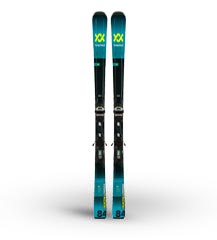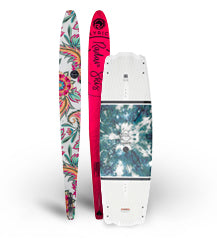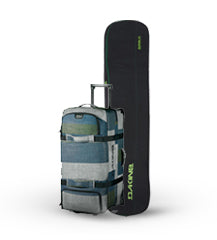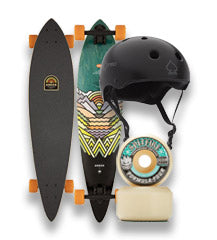How to Layer Clothing for the Snow to Keep Warm and Dry
July 31, 2021 5 min read
How to Layer Clothing for the Snow and Keep Warm & Dry
One of the most common questions asked about snow jackets and pants is “How warm are they?”. Every jacket and pant will have a different type and level of insulation and will be better suited to certain climates and weather conditions. To stay warm, dry and comfortable on the snow, you should work out the best layering system to suit you.
How Do I Layer For The Snow Properly?
Many people wear several layers of thermals and expensive puffy jackets and are still cold. With too many layers, your body can sweat and then your sweat will freeze, making you cold! Despite this, the weather on the mountain can be unpredictable, and it doesn't matter how good you are at layering.
There are several ways to layer for the snow, and it can depend on the type of jacket you wear, how cold you get and how cold the temperature is. Usually, three layers are adequate for Australian snow conditions. On warmer days, many people opt for a t-shirt and a jacket. And on colder days, some people wear an extra layer like an insulator. Generally, layering for the snow should consist of a base layer, a mid-layer and the outer layer. Finding the right layering combo for you can take a bit of trial and error, but once you figure it out, you will never look back.
Base Layers
A base layer or thermals is the first layer worn and acts like a ‘second skin’ to provide the foundation of warmth. The first layer traps body heat and wicks moisture away from the skin, reducing heat loss. Thermal layers are lightweight, breathable and work best when they are tight-fitting. The two most common thermal base layers are synthetic thermals or merino wool thermals.
First of all, leave your cotton t-shirts at home. Cotton shirts can absorb around 20% of its weight in water and take a long time to dry. Luckily, synthetic and merino based thermals are readily available to keep you warm, and some don’t even look like thermals.
Regardless of which type of base layer you choose, merino and synthetic thermals are designed to do the same thing; keep you warm and pull moisture away from your body.
Synthetic Thermals
Synthetic thermals are made from polyester or a polyester blend and are generally cheaper to buy. They have excellent moisture-wicking properties that help draw sweat away from the body and to the outside so it can evaporate. Synthetic thermals are durable and don’t absorb water which keeps them lightweight. The only downside to a synthetic base layer is that they can get smelly and need to be washed more often.
Merino Thermals
Merino base layers provide superior warmth and have natural anti-microbial properties to prevent odour. This means you can wear merino base layers day after day without them getting (too) smelly. While some people find regular ‘wool’ itchy, merino wool is slightly different because it is an ultra-fine fibre and softer than regular wool. Merino wool also has a kink in each strand which is how it retains heat so well and gives it a natural stretch.
Mid-Layers
The second layer for a warm snow outfit is a mid-layer. These are warm, insulating layers that help provide extra warmth to your core. There are a few options for mid-layers, but the most popular type is a fleece. An alternative type of mid-layer could be an insulator. An insulating jacket can be worn instead of a fleece or with fleece on a cold day. Vests have the advantage of keeping the core of the body warm without bulking out the arms, allowing for more unrestricted movement. They are available in any of the above materials.
Fleece Mid-Layers
Fleece mid-layers come in a variety of thicknesses and textures. Even the thinnest fleece will keep you warm on a cold day. Fleece is made from polyester fibres that are spun to create a moisture-wicking fabric that dries quickly. Which also keeps the fleece fabric lightweight and breathable. The best thing about wearing a fleece is that it will retain its warmth even if it gets wet.
Insulating Mid-Layers
Insulators come in many forms, and they usually are lightweight, compressible and block out the wind and chill. Down insulators are an excellent option for people who feel the cold and can be worn with a shell jacket for more versatility. They pack down easily under your jacket and offer the most warmth for the weight of any other insulating material. A more affordable alternative to down is a synthetic insulator that mimics down heat-retaining qualities. The main difference between the two is that when down gets wet, it doesn't dry and can lose heat. Synthetic insulators will retain heat when wet.
Outer Layers
The outer layer is the last piece to finish any warm snow outfit. This outer layer provides a waterproof and windproof layer to protect you from the elements. With so much variety in outerwear, it can be hard to navigate the labels and tags to find the right jacket for you. Two main types of outer layers are shells and insulating pieces. Shell jackets are generally one layer and are highly waterproof, windproof and breathable. Insulated jackets are exactly what the name describes and have an insulating layer. When choosing your outer layer, knowing which ratings make a specific jacket more waterproof than others is essential. To learn more about waterproof ratings, check out our Complete Guide to Waterproof Ratings, Insulation & Breathability guide.
Shell Outerwear
Shell jackets and pants are similar to a raincoat in that they are one layer of very waterproof fabric. Some shells have a thin flannel lining, and others feel more like a thick plastic bag. The waterproof and breathability rating will typically be relatively high and protect you from the elements. Shell outerwear pieces are easy to layer with, and for colder days, an insulator might be needed.
Insulated Outerwear
Insulated jackets and pants are the more popular outerwear style as they are almost a 2-in-1. They are filled with polyester-based insulation that works with the outer fabric to block wind and retain heat. Insulated outerwear pieces reduce the need for extra layers. A pant base layer is generally enough to keep you warm and comfortable when wearing insulated pants. When the weather is warmer on spring days, you might not need to wear the base layer pants.
Leave a comment
Comments will be approved before showing up.
Also in Blogs

How to Kneeboard for Beginners: Tips, Tricks, and Safety Advice
August 21, 2025 11 min read

The Ultimate Guide to Snowboarding at Rusutsu Resort, Hokkaido
July 15, 2025 13 min read

10 Wakeboarding Accessories Every Rider Needs in 2026
June 16, 2025 9 min read








